
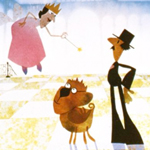 The early ’80s were an odd time for animated features. Though Disney had somewhat come out of a slump with the successful THE FOX AND THE HOUND and Disney-defector Don Bluth had some success with THE SECRET OF NIMH, most of the releases were off-brand, slightly off-kilter and remembered now as cult films at best: FLIGHT OF THE DRAGONS, THE LAST UNICORN, THE PLAGUE DOGS, as well as cartoons for adults or teens like AMERICAN POP, HEAVY METAL, HEY GOOD LOOKIN’, FIRE AND ICE and ROCK & RULE. Into this weird landscape came TWICE UPON A TIME, a movie with an entirely unique look and that doesn’t seem to be aimed at children or adults.
The early ’80s were an odd time for animated features. Though Disney had somewhat come out of a slump with the successful THE FOX AND THE HOUND and Disney-defector Don Bluth had some success with THE SECRET OF NIMH, most of the releases were off-brand, slightly off-kilter and remembered now as cult films at best: FLIGHT OF THE DRAGONS, THE LAST UNICORN, THE PLAGUE DOGS, as well as cartoons for adults or teens like AMERICAN POP, HEAVY METAL, HEY GOOD LOOKIN’, FIRE AND ICE and ROCK & RULE. Into this weird landscape came TWICE UPON A TIME, a movie with an entirely unique look and that doesn’t seem to be aimed at children or adults.
The story has something to do with dreams. In a city called “Din” (portrayed by live action footage and photos of San Francisco or somewhere), people who fall asleep will have good dreams if little animated blobs jump on their faces. But an asshole called Synonamess Botch sends vultures and a magic glowing spring (?) to stop the blobs and give the people nightmares instead. Meanwhile, back in whatever the magical place that’s not Din is called, there’s a guy called Ralph, the All-Purpose Animal, who changes to different animals or combinations of animals, and has the same voice as Garfield, Lorenzo Music. He has a sidekick called Mumford who’s a guy with a bowler hat who seems like maybe he’s supposed to be funny or something, but I’m unclear what he does. These two are sent on a mission to dump some garbage, but then sent on a different mission to steal “The Cosmic Clock,” which they break and accidentally stop time. Also there’s a fairy godmother involved and a guy called Rod Rescueman who is one of those Dudley Doright type characters who thinks he’s a super hero but is actually just a dumb muscly guy.
The closest movie to compare this to would have to be YELLOW SUBMARINE, but instead of great Beatles songs they have a couple by Michael McDonald’s sister Maureen and one by Bruce Hornsby. They seem completely out of place in such an otherwise timeless fantasy world, but oh well.
The reason to watch this movie, if there is one, is the stunning animation done in a technique they called “Lumage.” It’s a form of cut-out animation done with translucent plastic pieces lit from behind. This gives them texture and light effects impossible to achieve on cels (though it could be done on computers today). I mean, the only thing I can really do is show you some examples. These are all screengrabs I took, not concept paintings:

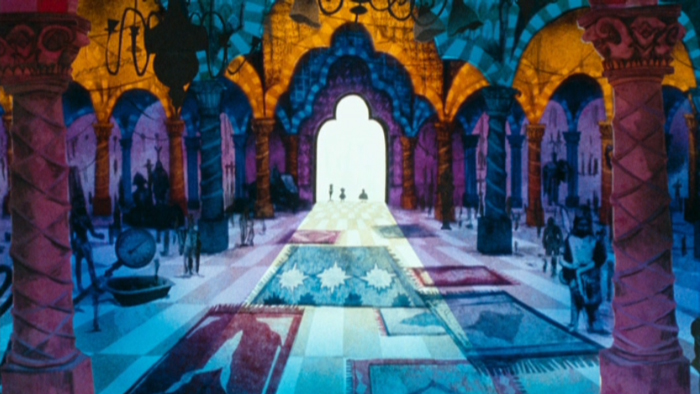
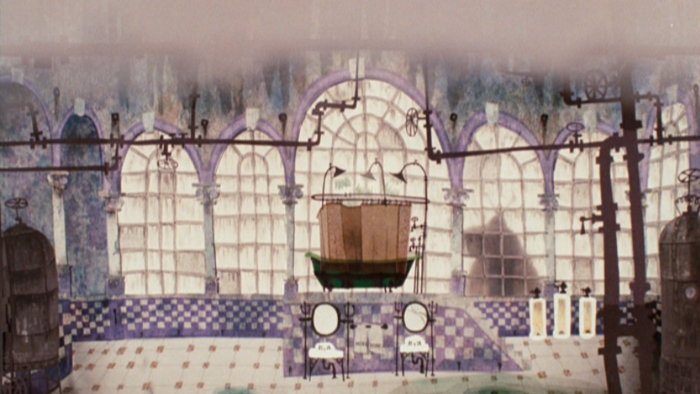
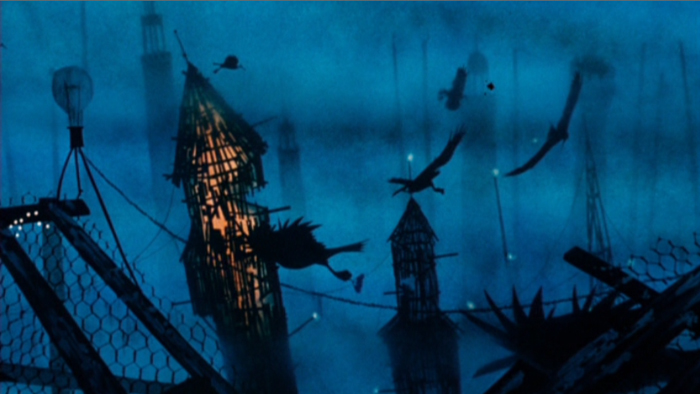
I guess that I chose frames where the characters aren’t prominent shows that I’m more into the backgrounds than the characters, but they look fine too. This is a triumph of design and color and lighting, in this case actual lighting as much as artificial lighting created with paint.
There are also a number of clever effects combining these characters with photographic backgrounds, a three-dimensional model of a bridge, an electric train, ink clouds filmed in an aquarium, etc. Apparently many of these tricks were devised and executed by 19 year-old David Fincher, who seems to have been a major part of the production judging by how many times he’s mentioned on the DVD commentary track.
I noticed in this scene of Din residents frozen in time that one of them is Henry Selick, director of THE NIGHTMARE BEFORE CHRISTMAS:
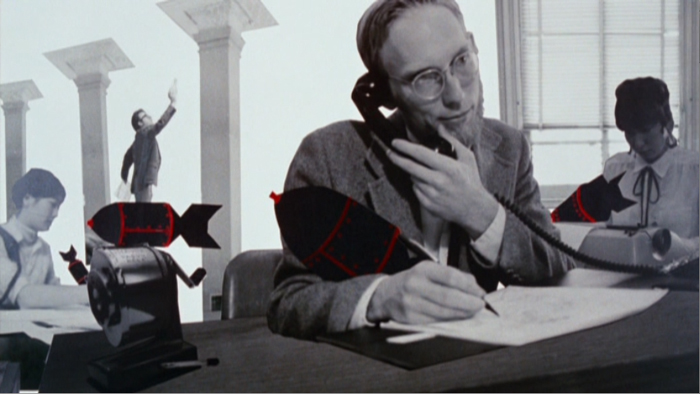
who, it turns out, was a sequence director who came up with alot of cool ideas too. So there were some talented people working on this and getting some good practice.
On a technical level the movie is outstanding and one-of-a-kind, but to be frankly honest I had a real hard time getting through its 77 minute running time. Though there are a couple of amusing jokes the characters are mostly annoying and the whole fantasy concept is as uninteresting as it is inscrutable. There is a guy in a jester hat called “Scuzzbucket” who is the “scream writer” who types on a giant typewriter with hammers. It looks neat, but I am unconvinced that this is a cool idea for how dreams are made.
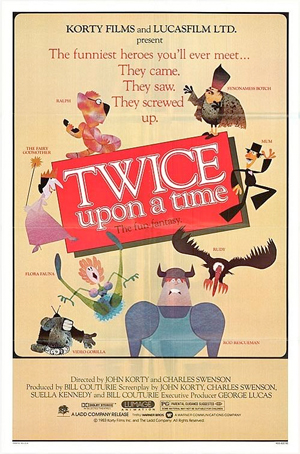 To me it seems too juvenile for older kids or adults but maybe too weird and nonsensical for little kids. I was honestly trying to figure out who they were trying to make a movie for. There are two credited directors: John Korty, normally a live action director, who created and developed the material, and animation veteran Charles Swenson. Swenson’s work actually spans a broad range of demographics. He’d worked on the fringes with the X-rated DIRTY DUCK and the animation in 200 MOTELS, as well as the hippie-dippy Puff the Magic Dragon specials, but also blatantly commercial works such as The Little Rascals Christmas and The World of Strawberry Shortcake.
To me it seems too juvenile for older kids or adults but maybe too weird and nonsensical for little kids. I was honestly trying to figure out who they were trying to make a movie for. There are two credited directors: John Korty, normally a live action director, who created and developed the material, and animation veteran Charles Swenson. Swenson’s work actually spans a broad range of demographics. He’d worked on the fringes with the X-rated DIRTY DUCK and the animation in 200 MOTELS, as well as the hippie-dippy Puff the Magic Dragon specials, but also blatantly commercial works such as The Little Rascals Christmas and The World of Strawberry Shortcake.
According to Korty’s websight TWICE UPON A TIME was meant to appeal to all of these audiences. “Children would love the characters and action, adults would enjoy the cleverness of the dialogue and young people would be drawn to the experimental nature of the animation.” I suspect it doesn’t have that type of broad appeal, but it never got much of a chance to find out. It was only released to theaters in Seattle and Portland, and for a weird reason. Disastrous test screenings caused worries that it wasn’t appealing enough to 15-25 year olds, so producer Bill Couturié (unbeknownst to Korty, who was off directing a TV movie) re-recorded some of the dialogue to add “about 15 instances of profanity.” Since the cussing version opened as a double feature with SECRET OF NIMH, unsuspecting parents were outraged and producers The Ladd Company pulled it from release. Though some people later discovered it on cable and VHS, it was never even released on DVD until Warner Archive put it out (with both soundtracks) a few months ago.
Couturié would go on to direct that movie ED, where Matt LeBlanc plays baseball with a monkey.
So what was Lucas’s part in all this? Nothing creative. Like with BODY HEAT, he was the guy who hooked his buddy up with Alan Ladd to get the movie made. Korty explains on his websight that after two years of pre-production “we showed the sample reel to my friend, George Lucas, who immediately took us to the Ladd Company, where a deal was struck to produce it in my Mill Valley studio.” On the DVD commentary he adds that the deal was done in one day, “and then frankly George had little to do with it after that. That’s no secret. It’s just, that was his main contribution was getting us going.” In the movie they do have clips of STAR WARS and RAIDERS OF THE LOST ARK pop up on a TV screen gorilla (long story) in tribute to him.
To Lucas, Korty was a collaborator and fellow Bay Area independent filmmaker. In a way he was actually a mentor to Lucas. According to an article in the Marin Independent Journal, seeing Korty’s studio set up in a barn in Stinson Beach inspired Francis Ford Coppola and George Lucas to believe they could “get out of Hollywood and set up a studio.”
The year after TWICE UPON A TIME came out, Korty worked more directly with Lucas, helming THE EWOK ADVENTURE for him. After that he continued with the TV movies, including one called MS. SCROOGE starring Cicely Tyson as Ebinita Scrooge. His last credit was 2009’s MIRACLE IN A BOX: A PIANO REBORN, an hour long documentary about restoring a piano. Swenson continued in animation, producing and writing for some of the Nickelodeon cartoons such as Rugrats and Aaahh!!! Real Monsters as well as providing the story for FIEVEL GOES WEST. He co-created a show called Mike, Lu & Og that ran for two seasons, seems to have retired around 2002.


























December 15th, 2015 at 10:52 am
I’m enjoying this series, Vern. It’s an interesting view of Lucas as a power-broker and human Kickstarter who lets his colleagues take chances. The man really is a juggernaut – special effects company, deal-maker, filmmaker. I think his lack of a forceful personality (I mean, other than a couple of catchphrases does anyone think that Lucas makes a strong impression in his interviews/behind-the-scenes stuff? I don’t.) and lack of self-aggrandizement have kept him in the public’s blind spot. He’s got as much juice as your studio heads, maybe more, but keeps in on the down low.